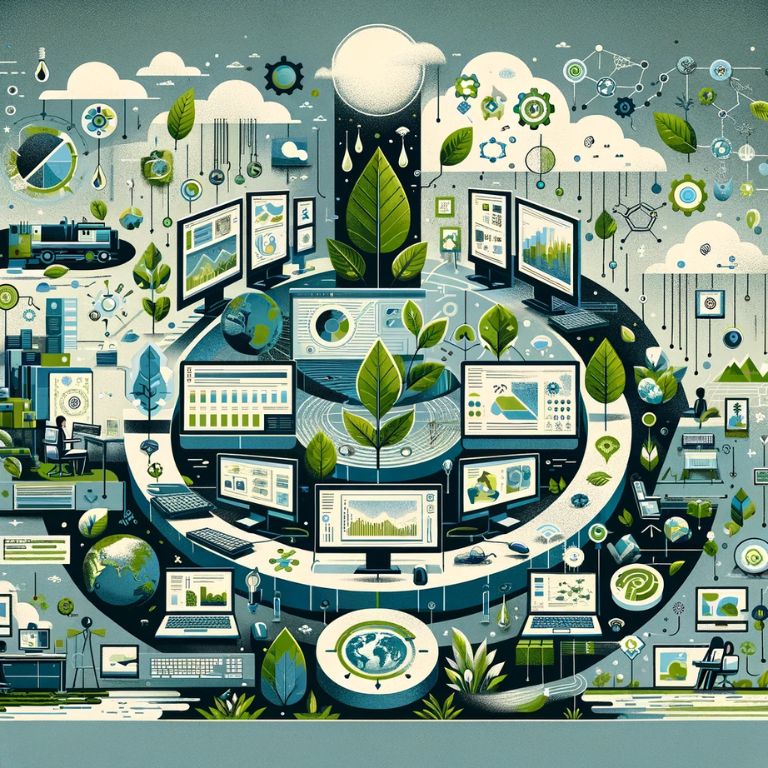As the world grapples with the escalating challenges of climate change, the role of computers and technology in addressing these issues is becoming increasingly vital. From predicting future climate conditions to optimizing resource use, computers have emerged as crucial tools in the battle against global warming and environmental degradation. This section delves into how computer technology, specifically advancements in artificial intelligence (AI) and machine learning, is revolutionizing our approach to combating climate change.
The Intersection of Technology and Environmental Science
The integration of computer technology in environmental science has opened new avenues for research and action. Advanced computing capabilities allow for the processing of vast amounts of environmental data, enabling scientists to understand complex climate patterns and predict future changes with greater accuracy. This data-driven approach is crucial in formulating effective strategies to mitigate the impacts of climate change.
The Role of AI and Machine Learning
AI and machine learning are at the forefront of this technological revolution. These technologies offer unparalleled capabilities in pattern recognition, predictive analytics, and simulation. AI algorithms can analyze data from various sources, including satellite imagery, atmospheric data, and oceanic patterns, to provide insights that were previously unattainable. For instance, AI is used to predict extreme weather events, model climate scenarios, and assess the effectiveness of various climate policies.
Applications in Climate Change Mitigation and Adaptation
The applications of computer technology in combating climate change are diverse and impactful. They range from optimizing renewable energy production to enhancing the efficiency of transportation systems. In renewable energy, AI is used to predict wind patterns and solar irradiance, optimizing the output of wind and solar farms. In transportation, machine learning algorithms improve the routing and efficiency of electric vehicles, contributing to reduced greenhouse gas emissions.
Artificial Intelligence and Machine Learning in Climate Action
The advent of artificial intelligence (AI) and machine learning has ushered in a new era in the fight against climate change. These technologies are not just transforming how we interact with the world but are also shaping our approach to environmental challenges. In this section, we’ll explore the various ways in which AI and machine learning are being employed to mitigate and adapt to climate change.
Enhancing Energy Efficiency
AI plays a pivotal role in optimizing energy systems. By analyzing patterns in energy consumption and weather conditions, AI algorithms can predict energy demand and adjust renewable energy supply accordingly. This results in more efficient use of energy resources and a reduction in reliance on fossil fuels. For instance, Google’s DeepMind AI has been used to predict wind power output 36 hours ahead, increasing the value of wind energy by 20%.
Transforming Transportation
Transportation is a major contributor to greenhouse gas emissions. AI is revolutionizing this sector by enhancing the efficiency of electric vehicles (EVs), improving traffic management, and facilitating the development of autonomous vehicles. AI algorithms can optimize charging times and routes for EVs, reducing energy consumption. Furthermore, AI-driven traffic management systems can decrease congestion and idling time, substantially lowering emissions.
Advancing Smart Agriculture
Agriculture consumes a significant portion of the world’s freshwater resources and contributes to greenhouse gas emissions. AI and machine learning are enabling ‘smart agriculture,’ which optimizes resource use and increases crop yields. AI-driven systems can provide precise information on when to plant, water, and harvest, reducing water usage and improving crop resilience to changing climate conditions.
Improving Climate Modeling and Prediction
AI and machine learning have significantly improved climate modeling and prediction. By processing vast amounts of environmental data, these systems can forecast climate trends and extreme weather events with higher accuracy. This helps in better planning and preparation for climate-related disasters, thereby reducing their impact.
Limitations and Ethical Considerations
Despite their potential, AI and machine learning in climate action are not without challenges. The energy consumption of AI systems themselves can be substantial, which needs to be managed effectively. Moreover, there are ethical considerations regarding data privacy and the potential displacement of jobs by automation.
Revolutionizing Climate Modeling with Advanced Computing
The advancement of computing technologies has significantly impacted climate modeling, providing more precise tools for predicting and understanding the Earth’s climate system. This section explores how modern computing is reshaping climate models, making them more accurate and comprehensive.
The Evolution of Climate Models
Climate models have traditionally been limited by computational capabilities. Early models could only offer broad predictions at large scales, often missing crucial details. However, recent advancements in computing power have allowed for the development of models with much finer resolutions. These models can simulate small-scale processes like cloud formation and ocean currents, which are critical for understanding climate dynamics.
Advanced Computing Languages and Machine Learning
A key aspect of this evolution is the adoption of modern, dynamic programming languages. The Climate Modeling Alliance (CliMA), for example, is developing a new climate model using Julia, a language that allows for more sophisticated simulations. This shift from older, more rigid languages enables the integration of complex processes and interactions within climate models.
Machine learning algorithms further enhance these models. They can process enormous datasets, like satellite observations and atmospheric measurements, to identify patterns and improve model accuracy. This approach allows for more reliable projections of climate phenomena, such as extreme weather events and long-term climate trends.
The Concept of Digital Twins
An intriguing development in climate modeling is the creation of “Earth digital twins.” These are highly detailed simulations of the Earth’s climate system, enabling scientists to study climate change scenarios in virtual environments. By closely mirroring real-world conditions, these models can provide insights into the potential impacts of various climate policies and actions.
Localized Predictions and Accessibility
Advanced computing is also democratizing climate modeling. The concept of “Earth digital cousins,” smaller models derived from the larger digital twins, aims to provide localized climate predictions. These models could be accessible to a wider range of stakeholders, including local governments and private-sector developers, offering them tailored information for decision-making.
Challenges and Limitations in the Use of Computers for Climate Change
While computers and AI technologies are vital in fighting climate change, they come with several challenges and limitations:
- Energy Consumption: Advanced computing, especially in AI and machine learning, requires substantial energy, often from non-renewable sources. This could paradoxically contribute to environmental issues.
- Data Privacy and Security: The reliance on large datasets raises concerns about the privacy and security of potentially sensitive information.
- Technological Accessibility: There’s a global imbalance in accessing advanced computing resources, with lower-income regions having less access, which could exacerbate inequalities.
- Data Dependence: The effectiveness of AI models hinges on the accuracy and comprehensiveness of the data, making them vulnerable to issues arising from poor quality or biased data.
- Sustainability of Technological Advancements: As technology evolves, there’s a need to ensure that it progresses in an environmentally sustainable manner, including energy-efficient computing and responsible electronic waste management.
Conclusion
The role of computers in combating climate change is a complex but promising landscape. Advancements in AI, machine learning, and climate modeling are critical tools in this battle, offering innovative solutions in energy, transportation, agriculture, and prediction models. However, these advancements come with challenges like high energy consumption, data privacy concerns, accessibility issues, and the need for sustainable development.
Balancing the benefits and drawbacks of technology is crucial. Sustainable and equitable advancement in technology is key to its effective use in climate action. Collaborative efforts among scientists, policymakers, and communities are essential in harnessing technology’s full potential for a sustainable future.




